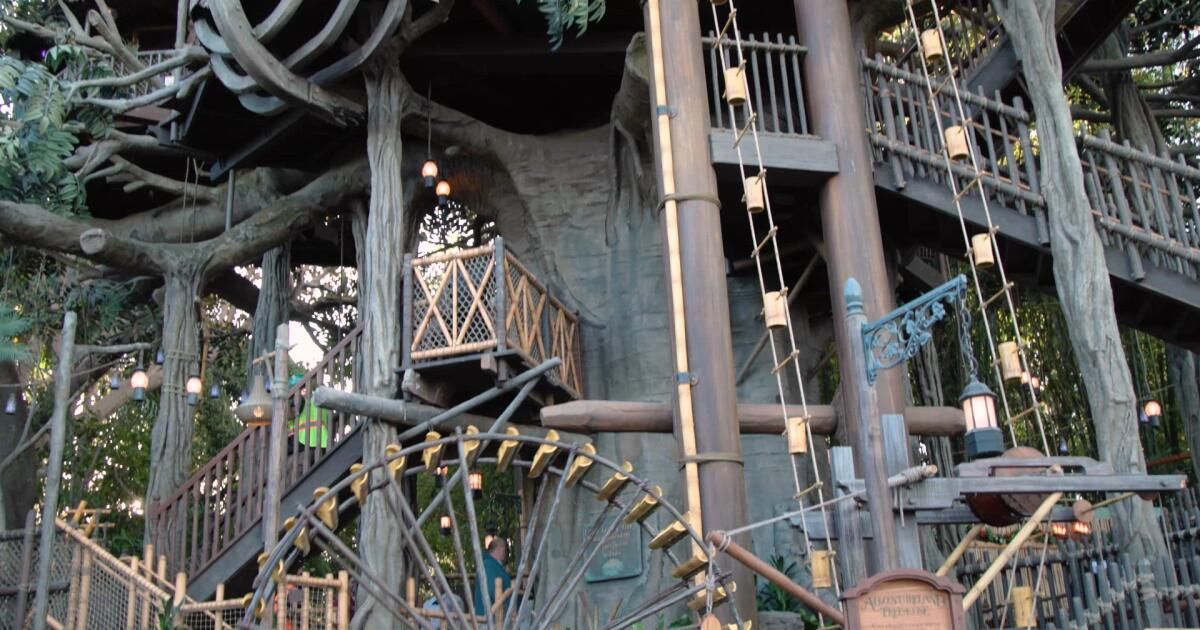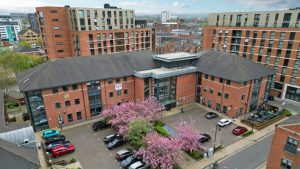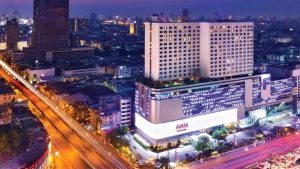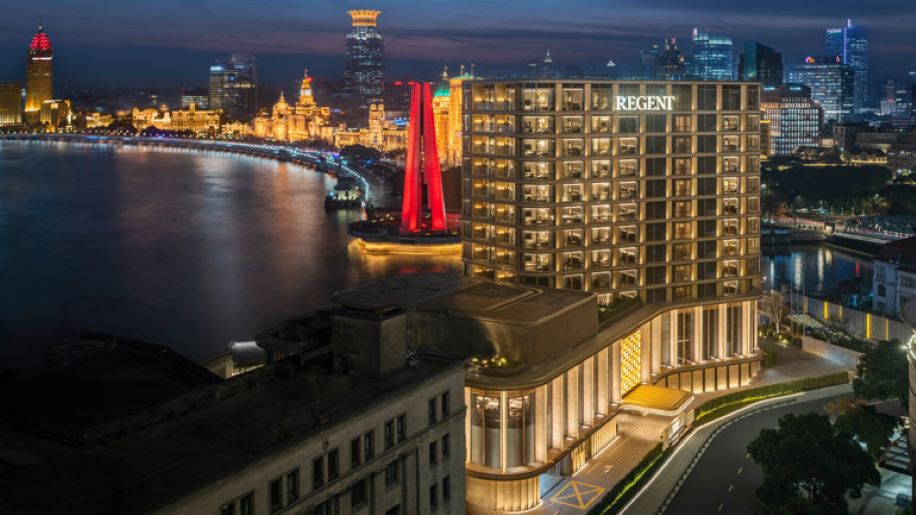No doubt, like many children, Kevin Kidney fantasized about living in Disneyland. But he didn't imagine himself fighting pirates or cavorting with ghosts. His special place was more serene.
Kidney's place was the original Swiss family treehouse, built in 1962 and hidden in Adventureland near Jungle Cruise. Her adoration of the treehouse instilled in him a lifelong love for the attraction and the movie it was based on. Kidney, now an accomplished designer and artist whose creative studio often collaborates with Walt Disney Co., remembers why the treehouse, an attraction that may be overlooked among today's trendiest thrills, is unique.
“It's one of the few rides that's very hands-on,” Kidney says. “You're pushing yourself at your own pace. Things you can touch (the tree trunk) give you a more sensory “you are there” experience. You’re not under a lap bar in a moving vehicle.”
In 1999, Disney renovated the Swiss Family Treehouse, updating it to reflect Walt Disney Animation's version of “Tarzan.” With this came some light interactive and digital touches, but Disneyland and Walt Disney Imagineering, the division of the company responsible for theme park experiences, have given Tarzan the boot.
By once again updating the treehouse, the park has looked to its past. The recently reopened Adventureland Treehouse, inspired by Walt Disney's Swiss Family Robinson (yes, that's its full name), shifts its focus to more old-fashioned theme park gimmicks.
Abstract, ambient storytelling and some cleverly designed mechanical animals (you'll want to spend some time watching Jane the Ostrich) have given Adventureland Treehouse a fresh but retro makeover. Numerous details, such as a large waterwheel, which provides a jolt of motion and energy to Adventureland's trails, nod to the original story, which was inspired by the 1960 Disney film “Swiss Family Robinson.” But as much as it draws on the history of the Swiss family, even keeping the families' names anonymous, it is not, the Imagineers say, the history of the Swiss family.
That makes Adventureland Treehouse the rare theme park attraction not tied to a modern Disney movie or series, or intellectual property (IP), in industry terms. Today, Disneyland and the park's patriarch, Walt Disney, have become their own kind of intellectual property, just as Disneyland has become something of a cultural institution built on multigenerational nostalgia.
“We don't have many opportunities to do this,” says Imagineer Michele Hobbs, one of the key architects of the Adventureland Treehouse renovation. “I think the treehouse, for most of us, is a once-in-a-lifetime endeavor. Honoring Walt's legacy and the legacy of the original Swiss family treehouse was important to us and the driving reason for creating this new intellectual property. While the original intellectual property was fantastic, we wanted to build on it today and bring a new family with its own unique qualities.”
Of course, there were other, more practical reasons for embarking on the year-long remodel. Over the decades, current and former Imagineers have talked about updating “Tarzan” as a way to ensure that a part of Disneyland history, dating back to Walt's era, can continue to have a home in the park. But more than 20 years after the animated film's release, the “Tarzan” property was becoming a little stale. With static figures that didn't move, Tarzan's Treehouse was also beginning to look and feel outdated.
“As the years went by, it became a little less popular,” Kim Irvine, the Walt Disney image maker and creative executive who was longtime art director at Disneyland, said of the original Swiss Family Treehouse. “The movie 'Tarzan' came out, so we decided maybe we should put IP in there and change the story to 'Tarzan.' This was successful for many years. …But now, we thought that intellectual property was not so popular anymore and really [wanted] to preserve that tree.”
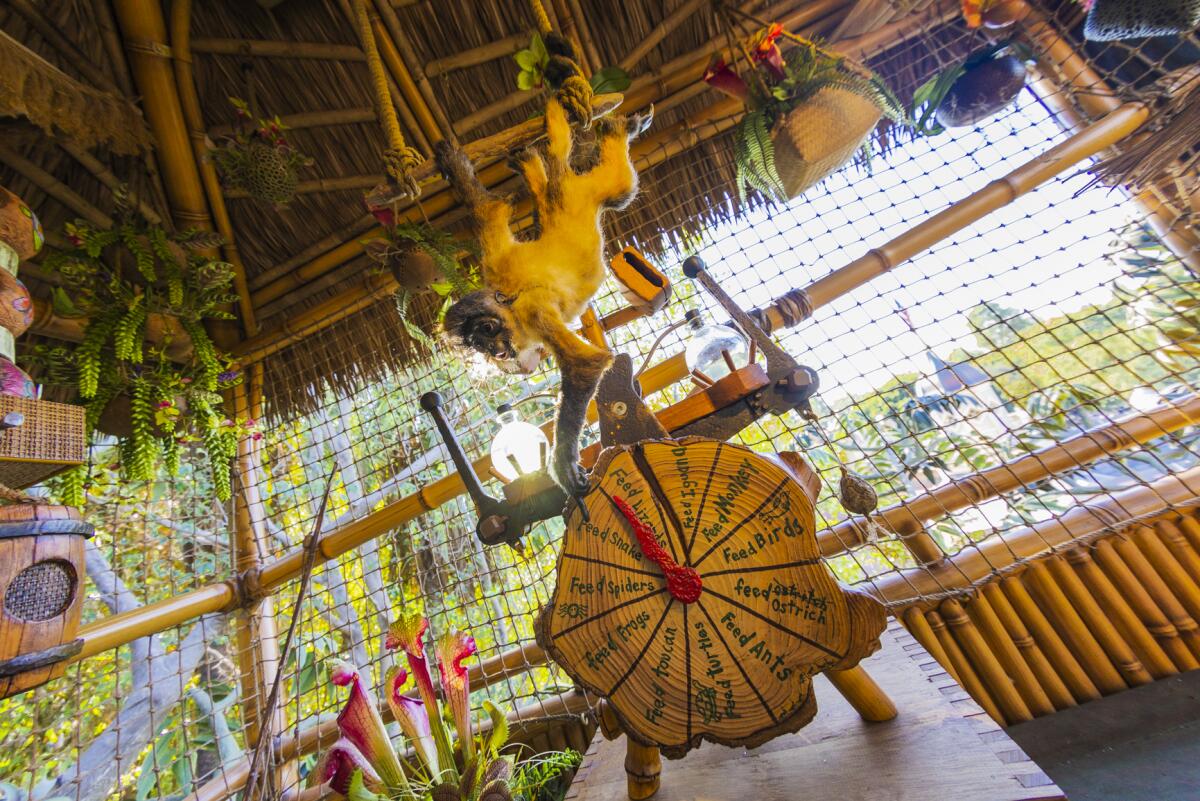
Fun scenes, like this monkey trying to manipulate a feeder, pepper Adventureland's Treehouse.
(Christian Thompson/Disneyland Resort)
The first order of business was to remove the suspension bridge of rope and worn wooden planks, as well as the ladder leading to it, which was added for “Tarzan.” This freed up significant Adventureland real estate and allowed sight lines to be redirected to the original treehouse and toward New Orleans Square. Imagineering then set out to recreate the original Swiss Family Treehouse waterwheel, asking the company's archives division to unearth the historic structure. It was in pieces today, but Irvine said the new waterwheel was built from molds of the original.
The waterwheel, says Kidney, who along with Jody Daily is working on a book inspired by the Disney movie “Swiss Family Robinson,” was a key piece of Disneyland lore. “It's really fun to see how the little bamboo cups collect water from the river and carry it to the top,” he says. “It was so cool. A big spinning waterwheel was kinetic. Without the waterwheel, it was just a tree house with steps to go up and down. It really looked spectacular with that water system. That's what It made you want to run and jump in there and figure out how it all worked.”
In the updated story, water has mystical powers, essentially providing energy to the treehouse and each of the rooms in the family of five. There are water pipes in every room, many of them connected to some type of mobile contraption. See, for example, the music room, where a brass-like, water-spitting elephant trunk powers instruments, including an ornate orchestra. In other rooms, the water powers an animal food timer for all the creatures and mammals that live in the treehouse. Here, guests will see a hanging monkey, trying to manipulate the clock to give it more food.
Animals abound throughout the treehouse. We're told to keep an eye out for fire ants, to spy small jumping frogs, and that many tree branches contain some kind of colorful pet. The new Adventureland Treehouse is a place built for patience. Expect guests to linger near the entrance, home to an ostrich named Jane, which is a reference to both “Tarzan” and a pivotal scene from the movie “Swiss Family Robinson.” Jane paces back and forth, up and down, giving the guests a questioning, skeptical look.
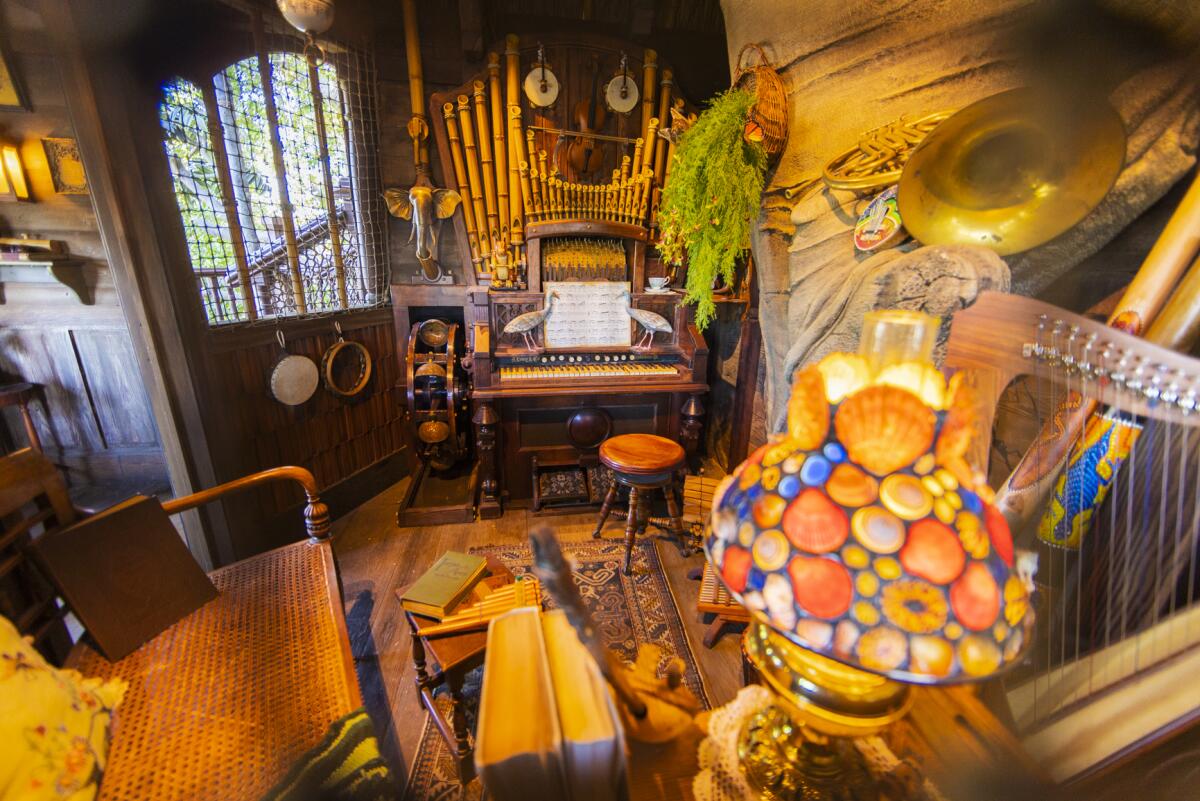
Mother's room in the Adventureland Treehouse, which is filled with musical instruments including harp, lute, guitar, and organ.
(Christian Thompson/Disneyland Resort)
“One direction from the beginning was fundamentally to make things visually lovely and not complicated and complex, to give people a chance to see a scene, see some kinetics and hear the audio,” Hobbs says. “This is a walk-through experience, so guests can spend as much time as they want. We wanted to check all the boxes for those who wanted to walk and those who wanted to stay. It is not prescriptive. It can be whatever you want it to be.”
It is worth noting, of course, that the treehouse has many steps and therefore will not be accessible to all guests. Irvine said Disney did an elevator study in 1999 when it added “Tarzan,” but found it wasn't feasible for the 1962 structure. This time, the Imagineers created an artwork room on the ground floor with interpretations of each space. main treehouse, which is designed to give guests who can't climb a taste of what's inside. Also on the lower level, of course, is Jane. Additionally, visually impaired people have the option of using an audio description while exploring the treehouse.
A happy song, the “Swisskapolka”, associated with the “Swiss Family” plays throughout the treehouse. Walt Disney Imagineering gave the song a new arrangement, one that is modified for each room in the space, as different figures or objects will move to the rhythm of the melody. It ensures that the song is less repetitive than it could be, as it becomes more of a curiosity work and each corner of the treehouse has its own spin on the number.
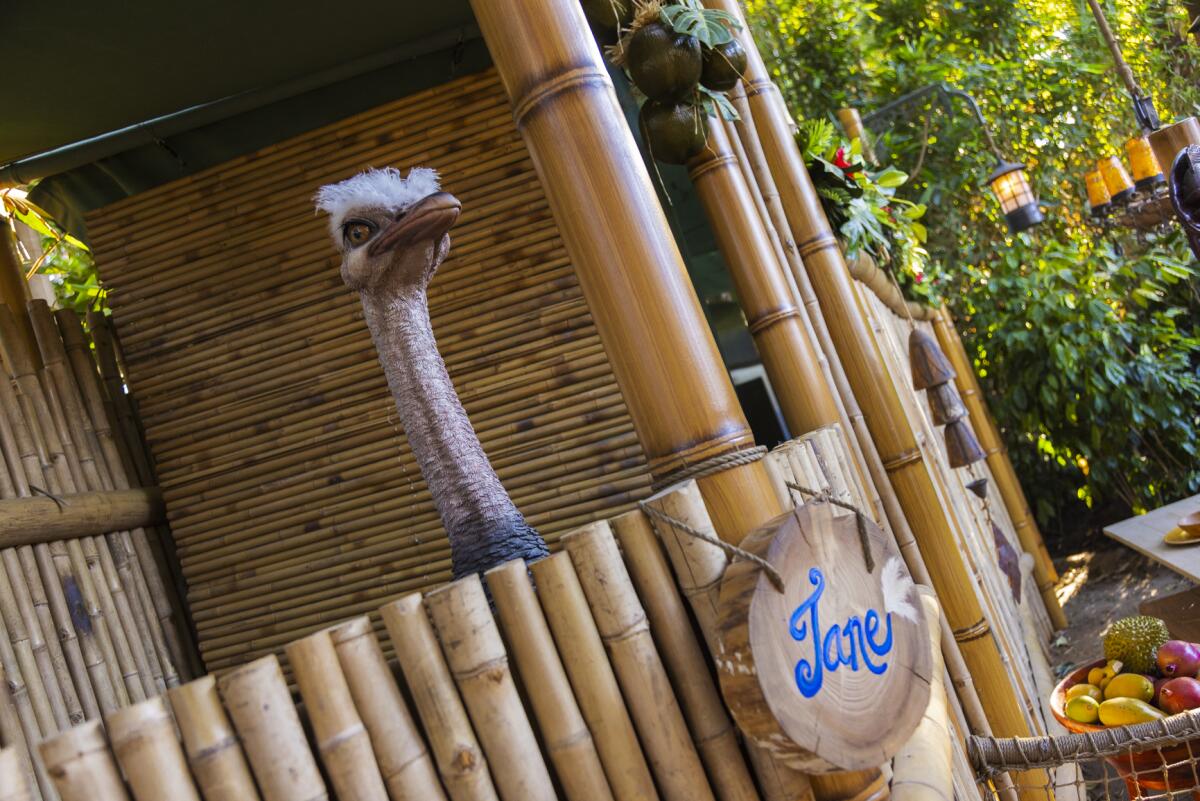
Jane the Ostrich at Disneyland's Adventureland Treehouse.
(Christian Thompson/Disneyland Resort)
The only room without the melody is the daughter's, as her astronomy-obsessed corner is equipped with a large telescope and moving planets in twilight tones. “The daughter is an astronomer,” Hobbs says. “She says, 'Hey, you guys have your own thing.' I'm going to play my songs here and read the charts.'” The space is calmer, with a more ethereal soundtrack.
But after the brief break mid-climb, we return to “Swisskapolka,” a song that has a certain upbeat quality to it. Kidney is glad to be back, because he gave the treehouse a sense of life.
“It's very fun and happy,” he says. “It works. It has a great beat and a rhythm that mimics going up and down stairs. It becomes the soundtrack to your treehouse climbing activity.”
Hobbs says a thematic goal of the renovation was to create something aspirational. That's a key reason, she says, why the characters remain somewhat anonymous.
“It was about creating a new story with characters that you or I could see ourselves being,” Hobbs says. “I could take my family there and we could play those roles and aspire to be in that room without having to associate it with anything else. While I go up to the daughter's room, my son or daughter could aspire to love astronomy, or go to the nursery and check out her love for animals and nature.”
The goal, Hobbs says, is to create an extension of the guest, to hint at “something they want to aspire to be.”
Unfortunately, however, for all the kids who dream of living in the treehouse, just like Kevin Kidney did, none of the rooms are available for rent.

